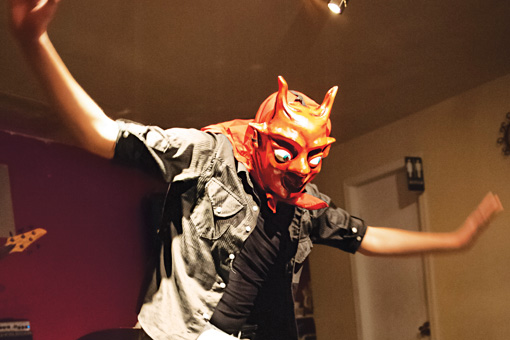Watch a video of Luis Antonio Vilchez dancing in Times Square below.
Passing through New York’s Times Square one winter day in 2010, Lima native Luis Antonio Vilchez noticed a group of street percussionists playing a familiar Afro-Peruvian rhythm—and immediately decided to join them. Soon, a large crowd gathered as Vilchez, wearing a button-down shirt and a winter coat, burst into a dance performance that was so impressive even the drummers watched in awe.
The same kind of impromptu creativity dominates Adú Proyecto Universal (Adú Universal Project), a nonprofit arts organization Vilchez founded four years ago to re-imagine Peruvian identity through dance, theater and percussion. Financed by money the group earns from its performances, Adú (which means “friend” in limeña slang) encourages its 20 members—all dancers—to combine different dance and music genres, crossing back and forth between tradition and modernity.
That sums up Vilchez’ approach to his art. A dancer since the age of four and a graduate of the Escuela Nacional Superior de Folklore José María Arguedas (National Superior Institute of Folklore), Vilchez has performed all over the world. He specializes in zapateo, a traditional Afro-Peruvian dance that involves intricate rhythm patterns executed through footwork and upper body clapping—which Vilchez makes his own by incorporating American tap shoes.
The 30-year-old dancer’s innovative style is further influenced by marinera norteña (Peru’s national dance), flamenco, hip hop, and even Michael Jackson. Exploring and mixing different styles has helped Vilchez explore his own identity, along with that of his multi-ethnic country.
Peruvians are often raised with racial and ethnic stereotypes that are difficult to overcome, Vilchez says. “Dance—and Peruvian dance in particular—demonstrates that different cultures can be integrated,” he explains.
Although he is not Afro-Peruvian, Vilchez says he’s always been drawn to music and dance from the African diaspora. “In this music, there’s…an element of an ancestral quest for freedom,” he adds. By expressing his deep pride in Peru’s diverse cultural heritage, Vilchez also hopes to inspire self-discovery, inclusiveness and openness in his audiences.
Adú’s first production, Sigo Siendo—a blend of theater, zapateo, American tap, hip-hop and musica chicha, (a type of music brought to Lima by rural migrants)—premiered in Peru in 2009 and addresses the lack of identity and low self-esteem that many Peruvians suffer because of racism and classism. The piece has been performed at dance festivals around the world. On December 4, Adú’s En Trance premiered at the Alianza Francesa de Miraflores in Lima, starring Vilchez alongside guitarist Ernesto Hermoza, pianist José Luis Madueño, percussionist Leonardo “Gigio” Parodi, and bassist Omar Rojas.
Meanwhile, Vilchez is reaching out to a younger audience. In 2014, Adú will teach youth in Vilchez’ old Lima neighborhood of La Victoria how to zapatear, with financial support from the United States Embassy. He hopes the workshops will help a new generation of Peruvians build their confidence and find their identity amid the many cultures that make Peru unique.
Watch a video of Luis Antonio Vilchez dancing in Times Square below.






